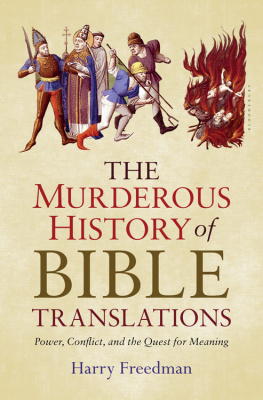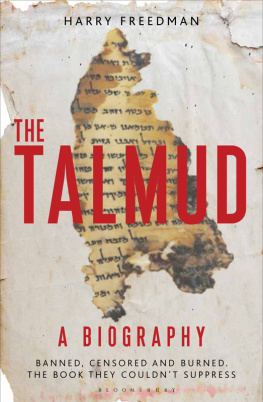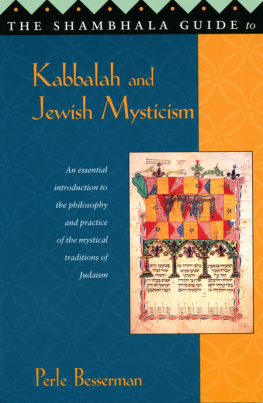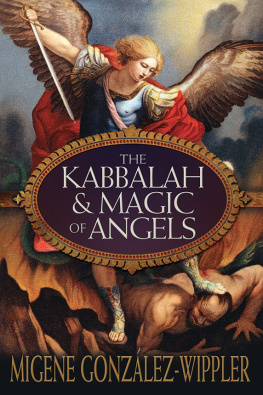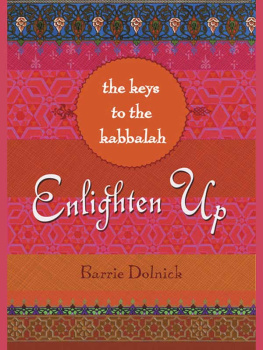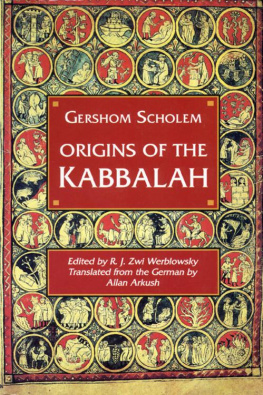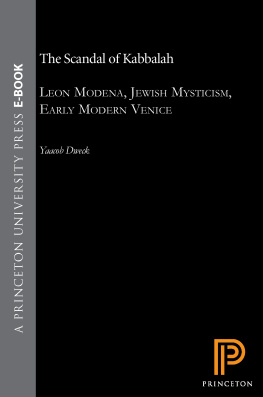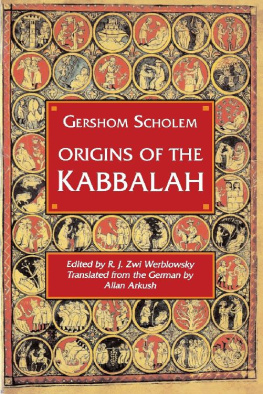KABBALAH
Dedicated to the memory of
Louis Freedman 19212017
Joan Freedman 19262018
For the winter is past, the rain has gone. The buds have appeared on the earth, the time for song has arrived and the voice of the dove is heard in our land.

Contents
Next time you meet a Hollywood celebrity, take a look at their left wrist. See if they have a knotted red string tied around it. If they do, the chances are they have visited a Kabbalah Centre, where red string can be bought for as little as $26 a length and small bottles of Kabbalah water for only $4 each.
The Kabbalah Centre used to say that their water was subjected to a process that restructured its intermolecular binding. After a BBC documentary challenged their assertion they dropped it from their website. In reality, Kabbalah water doesnt seem to be any different from the ordinary variety. Yet the claims made for its healing powers are outrageous. It is beneficial to soak ones feet in it, while meditating on letters from the Hebrew alphabet. It can, apparently, even cure cancer. Madonna, the most prominent of all the Kabbalah Centres devotees, planned to fill her swimming pool with it.
Red string bracelets are said to protect against the evil eye. Whatever its power, it didnt help David Beckham at the Euros in 2004; he wore the string, missed a penalty and England were out of the competition.
Neither red string nor Kabbalah water seems to offer much protection against calumny and scandal, if events surrounding the international network of Kabbalah Centres are anything to go by. Set up in the 1980s by an enterprising former insurance salesman and his wife, the Kabbalah Centre proved astonishingly successful in attracting wealthy celebrities, as well as selling string and water. At the peak of their popularity, which occurred perhaps not coincidentally around the turn of the millennium, their VIP visitors included Ashton Kutcher, Demi Moore, Lindsay Lohan, Elizabeth Taylor and Sandra Bernhard. Mick Jagger, Princess Eugenie of York, Kylie Minogue and Britney Spears are just some of those seen wearing the red bracelet.
But as the glamour years subsided, fraud and sex scandals began dogging the Centres reputation. Its leaders were accused of running a cult. Sandra Bernhard, who had first introduced Madonna to the Kabbalah Centre, summed it up: The wheels started to fall off Unfortunately, money corrupts everything, even spirituality.
By its very nature celebrity attention is ephemeral. It was bound to pass. Perhaps for the rock stars and movie icons Kabbalah was nothing more than a passing fad, a whimsy by which public lives could attempt to reconnect with their inner being. But there is nothing faddish about the philosophers, scientists and intellectual giants who have been drawn to Kabbalah. C. G. Jung, the founder of analytical psychology, brought the subject to the attention of post-war Europes intelligentsia, maintaining as he did that Kabbalahs portrayal of the cosmos reflected the structure of the human psyche. Gottfried Wilhelm Leibniz, the philosopher who claimed to have discovered the principles of mathematical calculus, dabbled in Kabbalah, while his great rival Isaac Newton studied and repudiated it. John Locke, the founder of modern political liberalism, the poet John Milton and maybe even William Shakespeare were familiar with Kabbalah. Today, scientists of a mystical bent point to the astonishing similarity between the fifteenth-century Kabbalistic description of the creation of the universe and the modern theory of the Big Bang.
Critics of Kabbalah and there have been many will point to the so-called cranks and social misfits whose Kabbalistic dabblings enabled them to impress, influence and often manipulate their more gullible followers. Aleister Crowley invariably tops this list, followed by Eliphas Lvi and a host of lesser-known occultists, of whom the most interesting is probably the obscure Dr Falcon, known as the Baal Shem of London. Centuries earlier, Kabbalahs weird and wonderful cast list had included Heinrich Cornelius Agrippa, immortalised in literature as Dr Faustus, the magician John Dee, Emperor Rudolf II of Prague and, as legend would have it, the golem who terrorised the streets of his city.
History is full of the names of those drawn to the mysteries of Kabbalah, some immersing themselves deeply, others barely scratching the surface. Yet, for the different ages in which they lived, and for the great variety of their lifestyles, they all had one thing in common. They all consumed Kabbalah as if they were plucking from a tree laden with ripe fruit. They barely gave a thought to how its theories were devised, how its cosmology had developed or how its mysteries had been revealed. That Kabbalah was a mysticism immersed in the Jewish tradition, with roots going back two thousand years, meant very little to them They knew nothing of the years of study, the self-abnegation and ascetic rigour which had enabled the classical Jewish kabbalists in Provence, Spain and finally Galilee to perfect their art.
And nor need they have known. For the most part the philosophers, magicians and scientists were drawing not on the Jewish tradition of Kabbalah, but on its Christian reformulation, conceived during the Renaissance by men like Pico della Mirandola and Johannes Reuchlin, Christian scholars of the Hebrew mysteries.
Arguably it was the divergence of Christian Cabala from its Jewish progenitor which paved the way for other Kabbalistic strands that emerged through the ages. Again arguably, it is the existence of these diverse strands that make it impossible for anyone today, even the classical kabbalists, to claim that theirs is the sole, legitimate expression of Kabbalah. That at least is the argument of this book.
Kabbalah today is more popular than it has ever been. In its classical Jewish incarnation it is practised and studied by mystically inclined Pietists in inward-looking communities. A world away, those seeking to overcome the stresses and conflicts of modern life take courses, read books and attend lectures on Kabbalahs contemporary manifestation. These two Kabbalahs speak to wholly different cultures, but they share the same story. It is the story I hope to tell.
Kabbalah was never meant to be fashionable. Its earliest exponents, deeply mystical, other-worldly Jews, studying in closed, secretive groups in twelfth-century Provence, would have been amazed, probably horrified, to hear how far and wide their doctrine has spread and how universal it has become.
The recent interest in Kabbalah emerged out of the hippy movements fascination with mysticism and meditation in the 1960s. It became particularly popular with the advent of New Age spirituality in the late twentieth century, when it was feted as a powerful technique for personal development. This was not Kabbalah as it had been practised in the twelfth or thirteenth centuries. But Kabbalah has always evolved, changed and bifurcated into different strands. The twentieth century was by no means the first time that Kabbalah had broken away from its early, exclusively Jewish confines.
Christian Cabala (note the different spelling) was conceived at the high point of the Renaissance, in Lorenzo de Medicis Florence. As the sixteenth century progressed it became allied to magic, alchemy and Hermeticism. Kabbalah contributed to the scientific revolution and played a central part in the nineteenth-century occult revival. Meanwhile, enigmatic new Kabbalistic practices and beliefs were becoming ever more closely embedded into mainstream Jewish life. Kabbalah is a rare example of a spiritual philosophy open to people of all creeds, yet one that does not detract from their faith. Today it is studied by more people, of all religions and none, than ever before.


